J. Donald Tillman
13 May 2001,
updated 28 June 2005
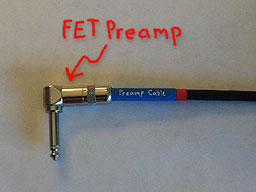
This article describes the Preamp Cable, my Guitarist's
Secret Weapon. A Preamp Cable is a phantom powered
discrete FET (Field Effect Transistor) preamp built into the
plug of a guitar cable. It provides almost all the
advantages of an on-board preamp with none of the disadvantages.
To the best of my knowledge I invented the Preamp Cable in 1992
and improved it in 1996, though it wouldn't surpise me if
someone has done this before. I've built up a number of
prototypes with subtle variations and have been using them ever
since.
This article is a report about several interesting aspects of
the project. It is not a set of step-by-step instructions
for constructing a Preamp Cable, although it's close.
What does the preamp do?
While the voltage off an electromagnetic guitar pickup can be a
healthy 2.0 Volts or so peak-to-peak if you're playing hard, the
impedance of that signal varies greatly over the frequency
spectrum and a high impedance signal can be damaged interfacing
to the outside world. The load capacitance of a guitar
cord can attenuate the high frequencies and lower the tuning of
the resonant peak of the pickup. The input impedance of a
guitar amp, mixer or effects boxes can attenuate or distort
parts of the guitar signal. And because the guitar signal
is not very robust, external noise sources and grounding can
become serious problems. The guitar's volume control
further increases the output impedance, multiplying the
problems.
Piezoelectric pickups suffer similiar problems, though the exact
mechanisms are different.
A preamp can address these problems by acting as a buffer,
providing the guitar pickup with an optimal high impedance load
and driving the cable, effects boxes, and amplifier with a
robust signal. The sound is ballsier, brighter, and more
responsive.
Why a Preamp Cable?
"It preamps anything it touches."
You can get most of the advantages of having a preamp installed in
your electric guitars, basses, or piezo-equipped acoustic
instruments
-
without having to carve up the your favorite instrument
(which can be important if it's an especially valuable
vintage model)
-
without having to install a bypass switch in case the preamp
or battery fails
-
without having to wear out the limited number of screw/unscrew
cycles of the instrument's wood every time you replace the
battery
-
without having to build a seperate preamp into each of your
instruments.
Additionally, it's easy to carry extra Preamp Cables as backups
in case of failures.
(An interesting question comes up; are there circumstances where
an on-board preamp has an advantage over the Preamp Cable?
Sure; exotic pickup mixing or cases where you want to preamp the
pickups individually before mixing them.)
FET Preamp
The preamp itself is a high quality, low noise discrete FET
circuit described in my article
A Discrete FET Guitar Preamp.
The design allows the circuit to be split into two parts at the
point where the FET is powered. The FET and a few
associated parts can be built into a standard 1/4-inch phone
plug on the near end of the cable while the remainder of the
circuitry and the battery can be housed in a small MXR-sized box
on the far end of the cable.
The preamp has a very high input impedance (3.0 M ohm), a
reasonably low output impedance (6.0K ohm), and a slight voltage
gain (around 3dB). It does not use opamps and therefore
avoids several classes of distortions that I personally don't
like.
Phantom power
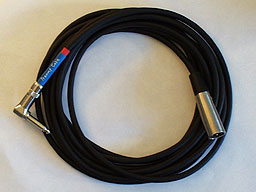
The Preamp Cable is "phantom powered", meaning that the power to
drive the preamp circuitry shares the same wire (the same piece of
copper) as the audio signal. This removes the weight and
the bulk of a battery and allows the preamp to be built into a
standard phone plug.
An XLR connector is used on the far end because it has a more
reliable connection for the dc current that will be present, so
the Preamp Cable will not be confused with a regular guitar
cable, and so the Preamp Cable can be connected to a standard
phantom powered mic input.
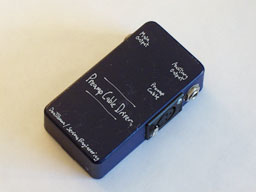 The little midnight blue box contains a 9-volt battery to power
the preamp as well as circuitry to split out the audio from the
power. No power switch is necessary as plugging the Preamp
Cable into the box effectively turns on the power. There
is a second convenience "Auxiliary Output" jack for a tuner.
The little midnight blue box contains a 9-volt battery to power
the preamp as well as circuitry to split out the audio from the
power. No power switch is necessary as plugging the Preamp
Cable into the box effectively turns on the power. There
is a second convenience "Auxiliary Output" jack for a tuner.
Battery life us six months or thereabouts, depending on use of
course. (Long battery life is hard to measure.)
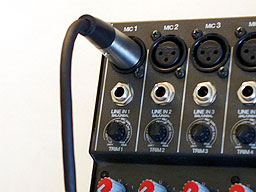
As an extra feature, it turns out that the Preamp Cable can just
as well be used with standard phantom powered microphone inputs
on a mixer (48 Volt, 6.8 Kohm, balanced). This is the way I
typically use it.
Also, you can use a standard microphone cable to extend the length
of a preamp cable.
Preamp Cable Construction
Here is the schematic and parts list for the Preamp Cable:
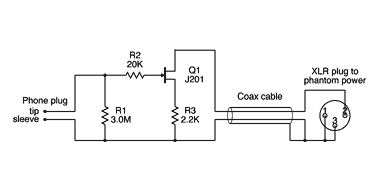
Preamp Cable parts list
| Q1 | J201 N-channel JFET |
| R1 | 3.0 Mohm 1/8-watt 5% resistor |
| R2 | 20 Kohm 1/8-watt 5% resistor |
| R3 | 2.2K ohm 1/8-watt 5% resistor |
| P1 |
1/4-inch phone plug, Switchcraft 280 (straight) or 226
(right angle)
|
| P2 |
3-pin XLR plug, Switchcraft A3M or Neutrik equivalent
|
The circuit is simliar to the left half of the circuit in my
Discrete FET Preamp
article. A 20 Kohm resistor has been added to the input for
protection from static discharge as the plug will spend some
time waving around in the breeze.
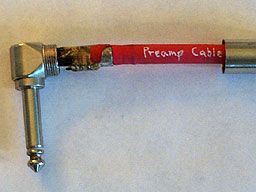
Obviously this is not the place for a cheap plug. I've
used both the Switchcraft 280 straight 1/4-inch plug and the
Switchcraft 226 1/4-inch right angle plug. The straight
plug is preferable for the inset jack on a Fender Stratocaster
while the right angle plug is preferable for most other
instruments. Alternately a Neutrik plug can be used; the
Neutrik plugs actually have a little more available space.
(Later note: I will definitely be using the larger Neutrik 1/4-inch
plugs for future preamp cables. My eyes aren't what they used
to be and the Neutrik models seem to have more working room.
Also their large size suggests that this is not just a regular
guitar cord.)
Due to FET manufacturing consistancy issues and power supply
limitations, the FET needs to be hand selected for the best
performance from this circuit. I recommend building up a
breadboard version of the circuit and substituting FETs until
the voltage at the drain is closest to 6.0 volts.
The circuitry is crammed into the space inside the plug.
This is not an easy operation and a small-tipped low power
soldering iron is essential. As is a lot of patience.
By itself the circuitry would be susceptable to mechanical
strain from regular cord use, so the inside volume of the plug
is filled with epoxy. Black electrical tape works well to
hold the epoxy in place while it hardens as well as insulating
any solder connections from the plug case. Additionally,
heat shrinkable tubing helps to limit the mechanical abuse of
the cable at the stress point. And labeling the cable is
important.
The XLR connector wiring is somewhat compatible with the AES XLR
spec:
XLR Connections
| XLR pin 1: | Ground |
| XLR pin 2: | Signal output |
| XLR pin 3: | Ground |
Preamp Cable Phantom Power Box construction
Here is the schematic and parts list for the Phantom Power box:
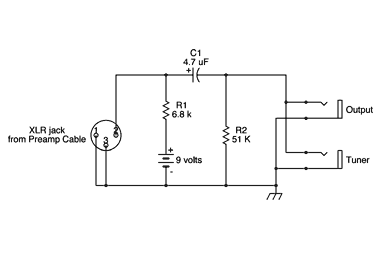
Phantom Power Box parts list
| R1 | 6.8 K ohm 1/4-watt 5% resistor |
| R2 | 51 K ohm 1/4-watt 5% resistor |
| C1 | 4.7 uF electrolytic capacitor |
| J1 | Switchcraft D3F XLR jack |
| J2, J3 | Switchcraft "11" 1/4-inch phone jacks |
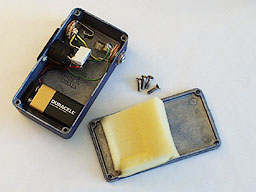 The enclosure is an off-the-shelf Hammond Manufacturing 1590-B
die-cast aluminum box, 2.34 x 4.39 x 1.22 inch (60 x 112 x
31mm). Guitarists call it an "MXR box".
The enclosure is an off-the-shelf Hammond Manufacturing 1590-B
die-cast aluminum box, 2.34 x 4.39 x 1.22 inch (60 x 112 x
31mm). Guitarists call it an "MXR box".
Stereo
"Anything worth doing is worth overdoing."
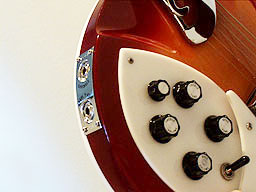 Not only is it possible to pack a preamp into a phone plug,
it is also possible to pack two preamps in a phone plug.
Not only is it possible to pack a preamp into a phone plug,
it is also possible to pack two preamps in a phone plug.
I'm a big fan of
Rickenbacker guitars,
and many Rickenbacker models come with stereo wiring. On
these models there are two separate output jacks; one labeled
mono and one labeled stereo. Typically one
uses the mono output, but the stereo output has
the bridge pickup through the bridge volume and tone contols on
the tip terminal and the neck pickup through the neck
volume and tone controls on the ring terminal.
Rickenbacker calls their stereo wiring "Rick-O-Sound".
The stereo wiring can be very useful. A stereo 12-string
instrument sounds heavenly. A guitar can have a lot of
space when one pickup goes through one effect while the other
pickup goes through another. You can fade in effects with
the volume controls. Or you can set up the neck and bridge
pickups as separate presets and use the pickup switch to bop
between them without physically being near a stompox.
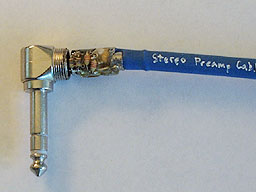
A Stereo Preamp Cable takes advantage of this.
The Stereo Preamp Cable uses a stereo (3 conductor) 1/4-inch
phone plug. I've used the Switchcraft 236 (right angle),
but the Switchcraft 297 (straight) or the Neutrik equivalents
should work fine. As with the mono version, this is not
the place for a cheap plug. The Preamp Cable circuitry is
doubled, once for the tip, once for the ring
contact. Construction is obviously more difficult due to
the physical size issues. Here in the photo some of the
circuitry can be seen inside the epoxy potting.
It would be a good idea to hand-match the FETs for the stereo
Preamp Cable.
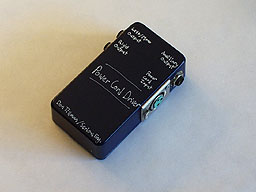 A stereo version of the Phantom Power box doubles the circuitry of the mono
Phantom Power box.
A stereo version of the Phantom Power box doubles the circuitry of the mono
Phantom Power box.
This table show the stereo wiring assignments from guitar to final outputs:
Stereo wiring assignments
| Guitar signal: |
bridge pickup |
neck pickup |
| Stereo phone plug: |
tip |
ring |
| XLR plug: |
pin 2 |
pin 1 |
| Output jacks: |
"Left/Mono" |
"Right" |
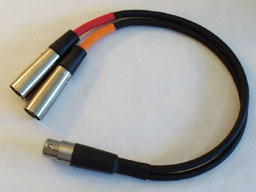
An XLR Splitter Cable is required to run the stereo guitar
directly into the phantom power mic inputs of a mixer. The
Splitter Cable has a female XLR input plug and left and right
maIe output plugs wired this way:
female XLR pin 1 to right male XLR pin 2
female XLR pin 2 to left male XLR pin 2
female XLR pin 3 to the remaining pins of the male plugs as
well as the cable shield

My personal favorite approach combines a Rickenbacker 370
12-string with stereo outputs, a stereo Preamp Cable, an XLR
splitter cable, and a Mackie mixer. This is what I used on
all the 12-string guitar parts on the
Tesseract
album.
How can I get a Preamp Cable?
Until someone goes into production with it you have to build one
yourself.
I've only built a handful of prototypes for myself and a couple
of friends. I'm not in the Preamp Cable manufacturing
business, so I'm not going to be making any more except to try
out some improvements.
In the summer of 1996 I shopped the Preamp Cable around, showing it
to various folks in the business, asking for advice and opinions,
and searching for someone interested in manufacturing and
distributing it. I was not successful, but I probably gave up
too early. (Special thanks to John Hall of Rickenbacker, Roger
Powell of Utopia, Bill Richardson of Gryphon Strings /
StudioGuitar and the folks at Gelb Music for all the expertise and
words of advice!)
Is the Preamp Cable patentable? Phantom powered preamps
have been around for a very long time so the basic technology is
not new, and this application is pretty much exactly what
phantom power was designed for in the first place, but this
specific implementation has some innovative details.
Nonetheless, a patent must be filed within a year of public
disclosure, and since I let the cat out of the bag years ago, a
patent is not going to happen.
I would be happy to work with a company to make the Preamp an
actual product. (Ah, the real reason for this article.)
Future improvements
If I were to build another batch of Preamp Cables I would make
some improvements.
- Use an even lower noise FET.
- For more headroom, run the Phantom Power box at 18 Volts
instead of 9 Volts, and optimize the FET circuit for that
voltage.
- Use an FET differential amp to reduce hum and noise and
also be more compatible with the AES XLR spec.
- Some other variations I'm still considering.
Later...
[This section was added later, June 2005.]
Jack Orman notes
(Patents on Parade #3, Impedance Matching Cable System)
that a patent was actually filed and issued for a preamp cable.
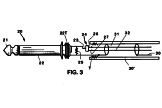 US Patent 5,585767:
US Patent 5,585767:
Impedance Matching Cable System for Electronically Coupling Musical
Instruments to Amplifiers
Thomas G. Wright, Jr.
Filed: 27 April 1995
Issued: 17 December 1996
This uses an FET mounted in a phone plug, so in that sense it's
similar to my circuit, but there are significant differences.
This circuit is a source follower, and so it provides no voltage
gain and has more headroom. It's only half phantom powered as
it uses a separate wire for the positive supply to power the source
follower and a negative phantom supply for the output. As
such, it is not usable with a phantom powered mic input on a mixer.
I'm not convinced that my original 1992 Usenet post would suffice as
prior art because, while the post does mention phantom powering the
circuit, it doesn't actually describe building the circuit into a
phone plug. Still, I'll claim this patent is not enforceable
because remotely powered preamps have been used all over for many
decades (condenser microphones, 'scope probes, hard disk drives,
medical instrumentation, etc.) and the patent introduces nothing
innovative.
And there are some weird issues with this patent. The author
never once mentions cable capacitance, yet that is the primary
reason for having a preamp near a guitar; it is the cable
capacitance that loads down the pickup. He does refer to this
as an "impedance matching" device, yet almost every guitar amplifier
has a 1.0 Mohm or greater input impedance. What sort of
amplifier input is he connecting a guitar to? In column 3 he
mentions connecting to a "power amplifier", but only there.
There are a number of errors in the patent. The FET source and
drain are inexplicably swapped throughout the text. (It is not
a problem in practice as most FET's are completely symmetrical with
no physical difference between the source and drain, but this is a
gratuitious confusion to include in an explanatory document. I
mean, we don't call it a "drain follower".) Neither the type
of FET (junction, MOS, enhancement, depletion) nor the polarity
(p-channel, n-channel) is specified. Figure 2 lists the
resistor value in milliohms (m) instead of megaohms (M).
Figure 3 is half mechanical drawing and half schematic, with the
plug casing drawn to look like a schematic and with the threads of
the plug casing drawn exactly as resistors. Claim 2 doesn't
make any sense at all; I think two concepts got mangled together.
The patent specifies that a 3 pin XLR connector is to be used to
connect the cable to the power supply. That is a good
connector choice electrically and mechanically, but from a user
interface standpoint it's a bad decision because it will be confused
with microphone cables or balanced line audio cables and this
circuit is not compatible with those applications.
He also missed an opportunity here -- in his design the plug pretty
much only contains an FET, which means that besides connecting the
FET as a source follower you also have the options of connecting it
as a low gain preamp or a high gain preamp depending on the details
of the power supply circuit.
So, if you want to go into production with a preamp cable, know that
this patent exists and that you might have to do something to either
prove prior art, be significantly different from the patent claims,
or talk to the inventor. I don't believe my preamp cable
circuit infringes on his patent as such, our circuits are different,
and details described in the "claims" section are different than
mine.
References


 The little midnight blue box contains a 9-volt battery to power
the preamp as well as circuitry to split out the audio from the
power. No power switch is necessary as plugging the Preamp
Cable into the box effectively turns on the power. There
is a second convenience "Auxiliary Output" jack for a tuner.
The little midnight blue box contains a 9-volt battery to power
the preamp as well as circuitry to split out the audio from the
power. No power switch is necessary as plugging the Preamp
Cable into the box effectively turns on the power. There
is a second convenience "Auxiliary Output" jack for a tuner.




 The enclosure is an off-the-shelf Hammond Manufacturing 1590-B
die-cast aluminum box, 2.34 x 4.39 x 1.22 inch (60 x 112 x
31mm). Guitarists call it an "MXR box".
The enclosure is an off-the-shelf Hammond Manufacturing 1590-B
die-cast aluminum box, 2.34 x 4.39 x 1.22 inch (60 x 112 x
31mm). Guitarists call it an "MXR box".
 Not only is it possible to pack a preamp into a phone plug,
it is also possible to pack two preamps in a phone plug.
Not only is it possible to pack a preamp into a phone plug,
it is also possible to pack two preamps in a phone plug.

 A stereo version of the Phantom Power box doubles the circuitry of the mono
Phantom Power box.
A stereo version of the Phantom Power box doubles the circuitry of the mono
Phantom Power box.


 US Patent 5,585767:
US Patent 5,585767: